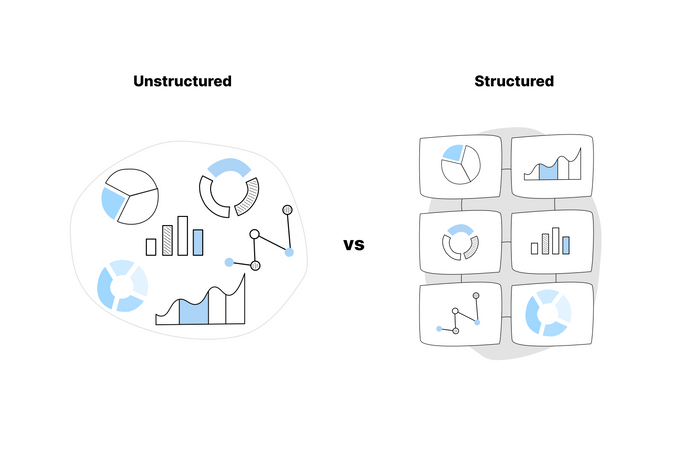Structured vs. Unstructured Data: Which One Gives Better Insights?
Updated June 29, 2023.

Data is how we make sense of the world around us. With data estimated to reach 181 zettabytes by 2025, finding the right information from the data we generate can be challenging. And data comes in two primary forms: Structured and unstructured.
Structured data has been in use for decades. Ever since System Query Language (SQL) was developed in the early 1970s, the potential benefits of structured data in a relational database were unlocked. And in the modern era, as machine learning (ML) and artificial intelligence (AI) come into their own, the power of raw, unstructured data is also within reach.
Let's dive deeper into the differences between these two data types.
Structured Data vs. Unstructured Data: Overview
| | Structured | Unstructured |
|---|---|---|
| Analysis | Quantitative | Qualitative |
| Searching | SQL-based methods | May need special tools and expert consultation |
| Storage | Takes up vertical storage based on hardware capacity | Amount of storage needed depends on the nature of the data |
| Format | Predetermined format that typically uses alphanumeric characters | Can be represented by various media, such as text, video, and audio |
What is Structured Data?
Structured data is highly organized and is stored in systems with fixed schemas known as data warehouses. Its rigid organizational structure makes it easy for ML algorithms to decipher. This stored data can be efficiently searched and manipulated through an SQL database.
Examples of Structured Data
- Names
- Phone numbers
- Addresses
- Accounting remittances
- Credit card numbers
✶ Want to know more? Try this beginner's guide to improving document management
What is Semi-structured Data?
The middle ground between structured and unstructured data is semi-structured data. It has no predefined data model, but it sorts data into preset fields using metadata like internal tags and markers. These metadata identifiers leverage search tools to make navigating and analyzing semi-structured data easier, even if it is mostly unstructured.
Your email inbox is one of the best examples of semi-structured data. Metadata tags enable users to search for keywords within hundreds of emails quickly and efficiently.
What is Unstructured Data?
According to a survey by Accenture, nearly 80% of companies' data is 50-90% unstructured. This data doesn't follow any predetermined schemas and is stored in ever-growing data lakes, where the data remains unstructured until data scientists extract what they need and organize it. Managing your company’s unstructured data can grant you a competitive edge.
Examples of Unstructured Data
- PDFs
- Images
- Video files
- Social media posts
- Audio files
Challenges of Unstructured Data
Until computing technology became capable, unstructured data was nearly impossible to analyze meaningfully. Now, with tools like ML and AI, it’s possible to comb through vast amounts of unstructured data to find exactly what you’re looking for.
However, there are challenges to dealing with unstructured data:
- Requires expertise: Data science knowledge is required, which can make tackling unstructured data intimidating to many smaller businesses that may not have the technical know-how.
- Needs special tools: Unstructured data is a relatively newer field compared to structured data. So, examining it requires specialized tools designed to handle various formats and volumes.
- Limits product choices: Special tools and skills for analyzing unstructured data are still being refined. Therefore, there isn't a wide selection of options for data managers when dealing with this type of data.
✶ Find out more about data silos and data lakes
Sift Through Data Seamlessly With Unleash
While structured and unstructured data are distinct forms, they are often found together—businesses can gain insights from both structured and unstructured data. Internal and external sources combine to create a stored, growing body of knowledge. The larger that body of knowledge grows, the more time-consuming it becomes to navigate.
Enter Unleash—the enterprise search tool that streamlines productivity across your organization. It spares you and your colleagues from digging through files and folders by searching entire databases in a flash. It’s simple and easy to use, so you can gather insights with fast data navigation.





